Venus flytraps are native to the United States east coast. They grow naturally in the states of North Carolina and South Carolina. However, people cultivate Venus flytraps all over the world. To be a successful Venus flytrap grower, you must try to mimic their natural habitat. Venus flytraps grow with an abundance of sunlight in very humid terrain, which lacks nutrients. As a fellow carnivorous plant grower, I would like to share my research and experience from growing Venus flytraps. I hope you enjoy this complete guide to Venus flytrap care!
Venus Flytrap Care
The following sections cover vital considerations for Venus flytrap care:
Light
Venus flytraps require a lot of sunlight. They need about 12 hours of sun a day. However, Venus flytraps can live in partial shade, but they must receive 4 – 5 hours of direct sunlight. For people living in sunny areas, the light requirement shouldn’t be a problem. However, some people live in darker areas. “Can you still grow carnivorous plants? Yes. In fact, even if you live in a dark basement or a densely shaded house in a redwood forest, carnivorous plants can thrive even in the darkest corners. The solution is to grow them under artificial lighting” (D’Amato, 2013). There is a wide variety of plant light options in the market. High Output fluorescent lights are suitable for Venus flytraps.
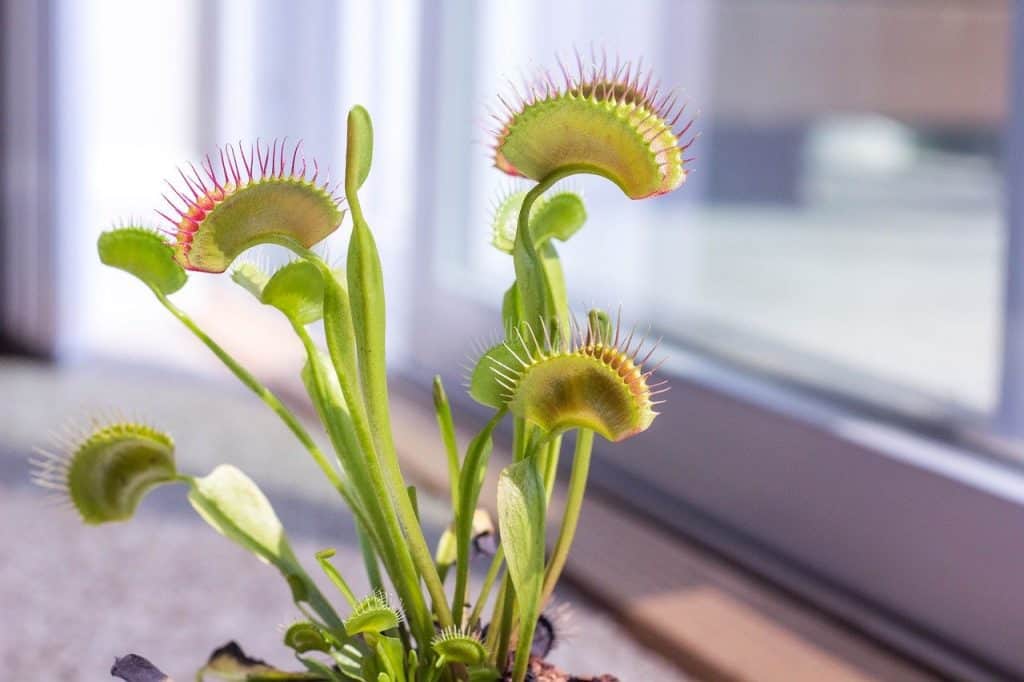
Water
Venus flytraps need a lot of water. Never let the soil dry out. The ground needs to be moist at all times. Also, you can’t water your plant with tap water (it has too many minerals and salts). Instead, use rainwater or distilled water.
Feeding
Venus flytraps need certain elements from the insects they consume because the soil they live in lacks nutrients. Venus flytraps can survive several months without catching prey. However, they won’t thrive without proper feeding.
When you grow Venus flytraps outdoors, they can catch prey on their own. But, when you grow them indoors, you will have to take care of the feeding. There are a lot of menu options to feed your plant. Venus flytraps eat a variety of bugs, such as crickets, beetles, grasshoppers, spiders, slugs, flies, and ants. You must be very careful in the size of the insect you are using. The bug should not be larger than 1/3 of the size of the trap. It is better to opt for a smaller bug than using one that is too big. If the prey is too large, the leaf won’t be able to digest it. Then, the trap will wither and die.
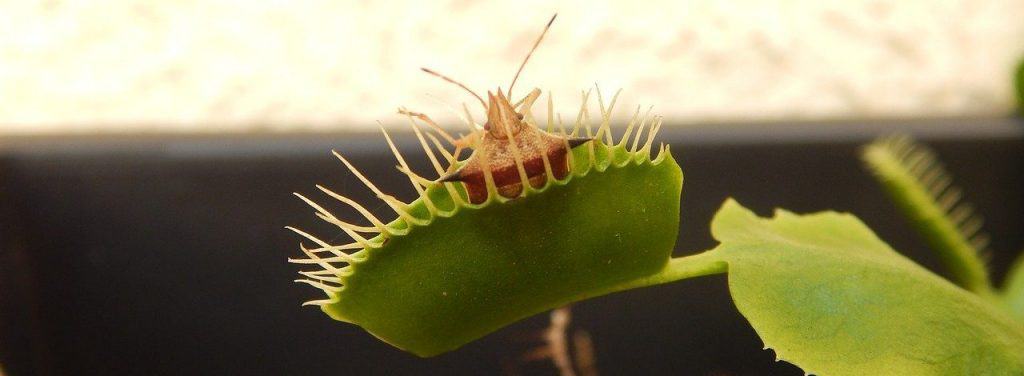
A common mistake is to overfeed your plant. For best results, only feed your Venus flytrap once every two to four weeks. Also, you only need to feed one trap on the entire plant at a time.
For more information, read our complete guide on how to feed a Venus flytrap:
Soil
Venus flytraps require nutrient-free soil with drainage. Most growers utilize a combination of these components to create a Venus flytrap friendly soil: Long-fibered sphagnum moss, sphagnum peat moss, sand, and perlite. You can find all of these components in any gardening store. Or, you can purchase a specialized carnivorous plant blend. Peat and Sphagnum moss hold water to provide the high humidity/moist environment we need. And, perlite and sand help with drainage and loosen up the soil.
Fertilizer
Fertilizing is an essential step when caring about most plants. However, Venus flytraps are unique in this aspect. There is no need to fertilize them. Venus flytraps can not handle minerals (hence the distilled water and nutrient-free soil). All in all, avoid fertilizing your plant. Fertilizers can weaken and eventually kill Venus flytraps. If you are concern about your plant not getting enough nutrients, focus on proper feeding rather than fertilizing.
Flowering
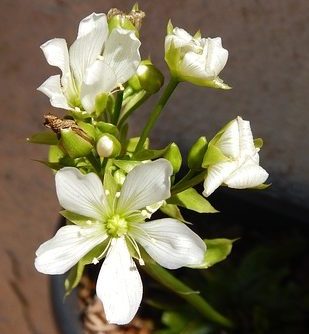 During the spring months, Venus flytraps grow flowers. Thick cylindrical structures spur from the center of the plant and grow to become white flower bundles. First-time growers tend to get excited with the spur of flowers and let them flourish. However, the advice for amateur growers is to cut the flower stalks as soon as possible.
During the spring months, Venus flytraps grow flowers. Thick cylindrical structures spur from the center of the plant and grow to become white flower bundles. First-time growers tend to get excited with the spur of flowers and let them flourish. However, the advice for amateur growers is to cut the flower stalks as soon as possible.
Venus flytraps spend a lot of energy producing flowers for reproduction. After flowering, Venus flytraps are weak for weeks or even months. Novice growers should not take the risk to grow flowers and weaken their plant. Instead, they should consider cutting the flowers off when they spur. A single plant attempts to grow several flowers during a season. Therefore, you should keep close attention to your Venus flytrap during spring.
For more information, you can read our Venus Flytrap Flower Guide:
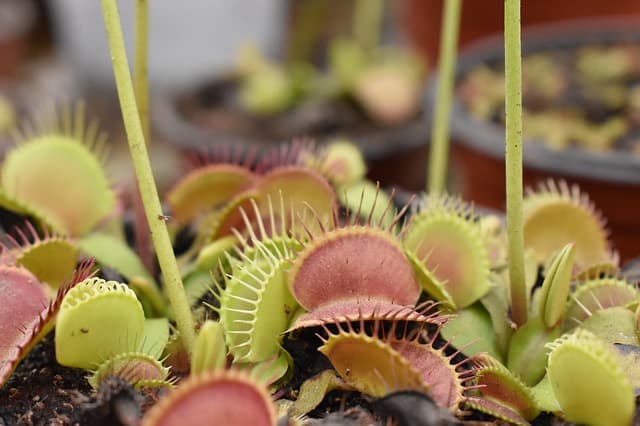
Black Leaves
Venus flytraps grow five to ten traps at a time. Older traps eventually turn to a dark black color and whiter. This process is entirely normal. So, do not worry if some of your traps are turning black. Also, do not chop off traps when they start turning black. When the trap starts turning black, it is still an essential part of the plant for photosynthesis. Instead, wait until the leaves whiter entirely. Then, carefully cut them out. The photo below shows a couple of Venus flytraps growing in the wild. If you look carefully, you can notice the dead black leaves on the edges of the plant. Again, those are entirely normal.
When should you worry about black leaves?
Generally, a new leaf should grow for every dead leaf. Start to worry or take action if you notice an increase in black leaves on your Venus flytrap. If the plant is not entering dormancy (read below), then there must be something wrong. Review the other care item such as water, soil, and light and make sure your setup is proper. Also, sometimes Venus flytraps lose leaves due to stress, which can be caused by constant movement, excessive heat, or recent repotting.
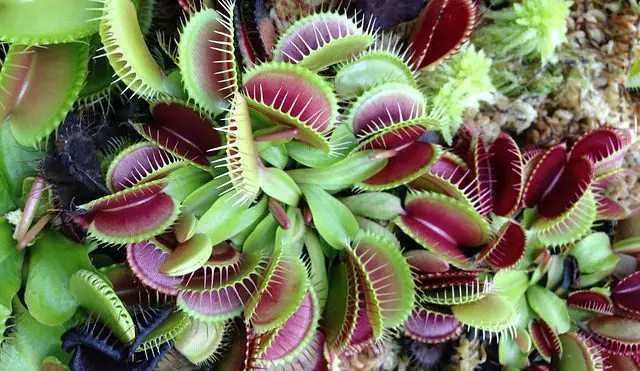
Dormancy
In the wild, Venus flytraps undergo a dormancy period every year. During late fall or winter, Venus flytraps will go dormant. Their dormancy period is analogous to animal hibernation. The plant needs to rest for about three months. After the dormancy period, in the spring, Venus flytraps return to their original state and continue to grow and develop.
The physical changes on Venus flytraps due to dormancy are very noticeable. When temperatures start to drop, Venus flytraps go dormant. During dormancy, several leaves wither, and the plant reduces in size. First-time growers sometimes panic when they notice the changes. But, this process is normal, and it is a crucial stage for the plant’s development.
Natural Dormancy
Venus flytraps have evolved to go dormant during the winter. They do it naturally in North Carolina and South Carolina when the temperatures start to drop (usually sometime between October and December). Depending on your geographical location, you might be able to provide the appropriate conditions for your plant to go dormant.
Venus flytraps require a dormancy temperature between 45 F (8 C) and freezing (32 F / 0 C) [1]. If you live in a geographical location that archives those temperatures, consider placing your plants in a porch, garage, or basement (and don’t forget about all the other Venus flytrap care instructions, including lightning). Then, leave your Venus flytraps in that cold weather for a few months. During that period, you should be careful with extreme temperatures. Do not let your plant freeze! Finally, once dormancy is over, slowly introduce your plant to warmer weather. You will notice a dramatic change in appearance. Venus flytraps go from looking almost dead during dormancy to flourishing at its finest during spring.
Induced Dormancy
Some locations never experience a fall or winter temperatures below 50 F, or perhaps, they do achieve cold temperatures, but only for a couple of weeks. In those locations, it can be almost impossible to reach the natural dormancy state of Venus flytraps. As a last resort, you can induce dormancy by placing your plants in the fridge. There is a whole process associated with this method of inducing dormancy. Read the article below for the complete detail on the refrigerator dormancy method.
Refrigerator dormancy: Winter is Coming! A Guide to Venus Flytrap Dormancy
Skip Dormancy
Yes, it is possible to skip dormancy. However, it is not healthy. Your Venus flytrap won’t die right away, but its life span will reduce significantly. A healthy Venus flytrap can live for 20 years or more. But, if you skip dormancy, your plant will die within a couple of years.
Final Thoughts
It is easy to make mistakes when you are a beginner or first-time Venus flytrap grower. Becoming a successful carnivorous plant grower requires patience, practice, and attention to detail. Get started by learning about your plant. Then, build a proper setup considering all care instructions. Later on, while your plant grows, be attentive to sudden changes in climate and your plant’s behavior. I hope you enjoyed these Venus flytrap care instructions. Best of luck growing large and healthy Venus flytraps!
Related Questions: Venus Flytrap Care
How hard is it to keep a Venus flytrap alive?
It is not difficult to keep Venus flytraps alive. The starting point is to build a setup with the appropriate soil and a lot of sunlight and water (distilled). After the installation is ready, then, focus on avoiding these common mistakes to keep your plant healthy:
- Do not overfeed your plant: Only feed your plant once every 2 to 4 weeks.
- Do not feed human food to your plant: Venus flytraps are designed to consume insects. Other food might take too long to digest and create a bacterial infection.
- Avoid playing with your plant’s traps: Venus flytraps use a lot of energy controlling and activating those traps.
- Do not fertilize: Venus flytraps prefer nutrient-free environments.
- Skip the flowering process: Cut the flower stalks early to let your plant mature and grow early.
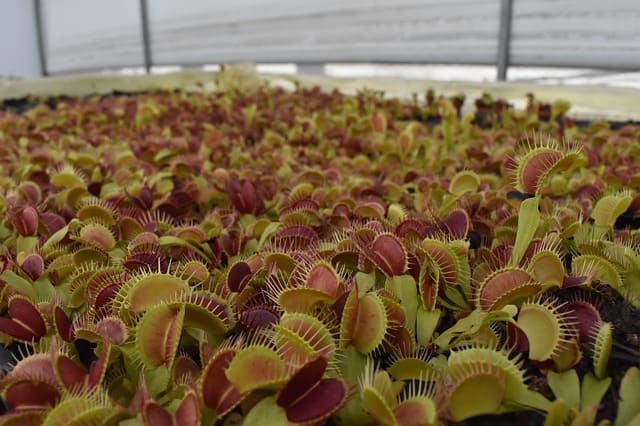
Can you keep a Venus flytrap indoors?
Yes, it is possible to grow Venus flytraps indoors. The care instructions remain the same, but you should be careful with some details. Here are a few important considerations:
- Feeding: You will need to take care of feeding your plant since it won’t be able to catch prey.
- Lighting: Find a bright spot indoors where your plant can receive 12 hours of sunlight. If you do not have access to natural light, you will need artificial light.
- Water: Same as outdoors (utilize distiller/rainwater).
- Dormancy: Weight your options between natural and induced dormancy
- Let your plant go dormant naturally in temperature between 45 F (8 C) and freezing. For example, you can place your plant in a cold porch, shed, or garage for the winter.
- If you naturally do not have access to such temperatures, consider induced dormancy. Skipping the dormancy period will eventually kill your plant.
- Stress: Place your plant in a tranquil area without constant movement. Movement can produce strain and ultimately cause your plant to lose leaves and deteriorate. For example, avoid placing your plant in a window that will constantly be opening and closing or a window with a curtain that always touches your plant.

